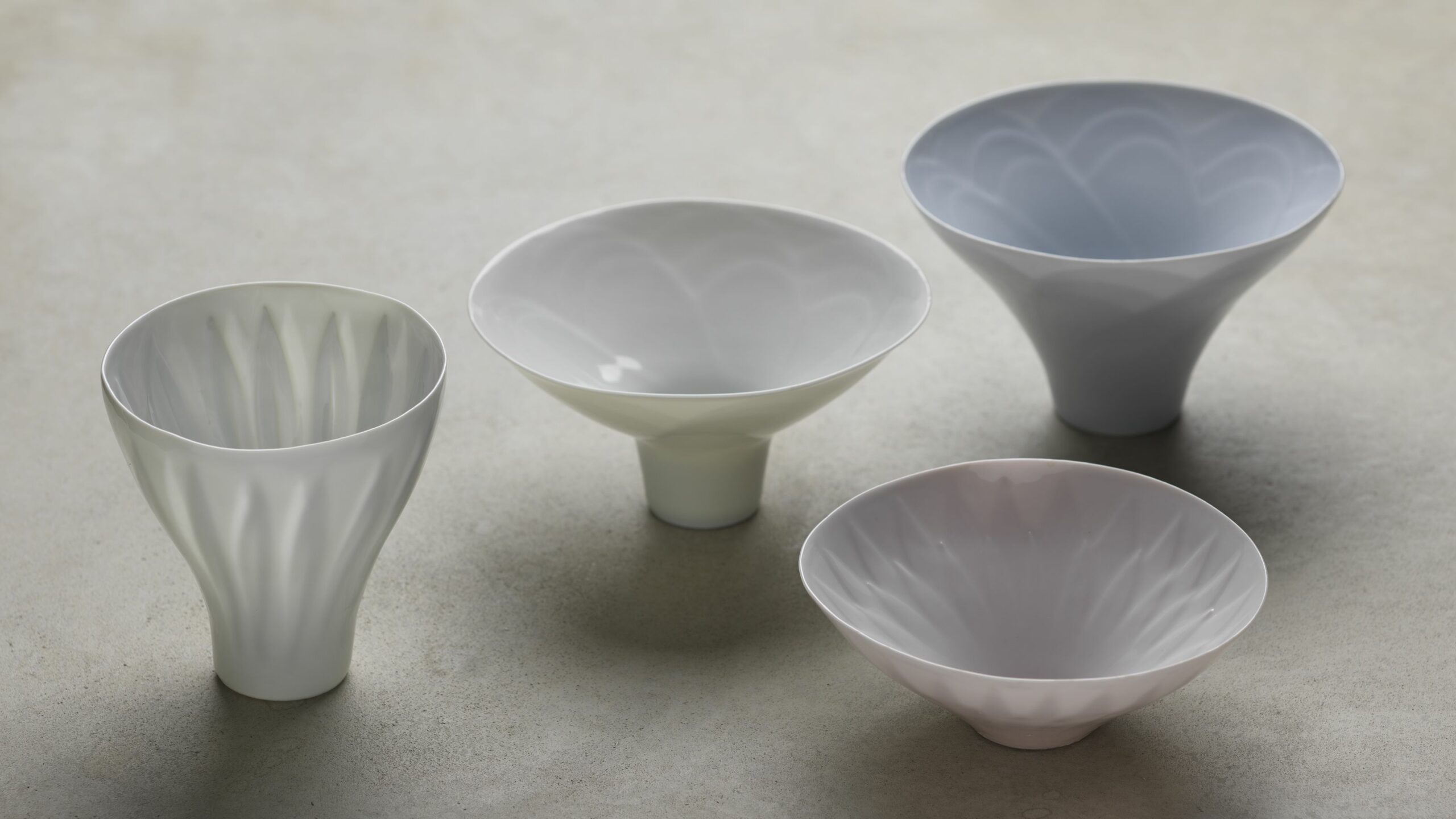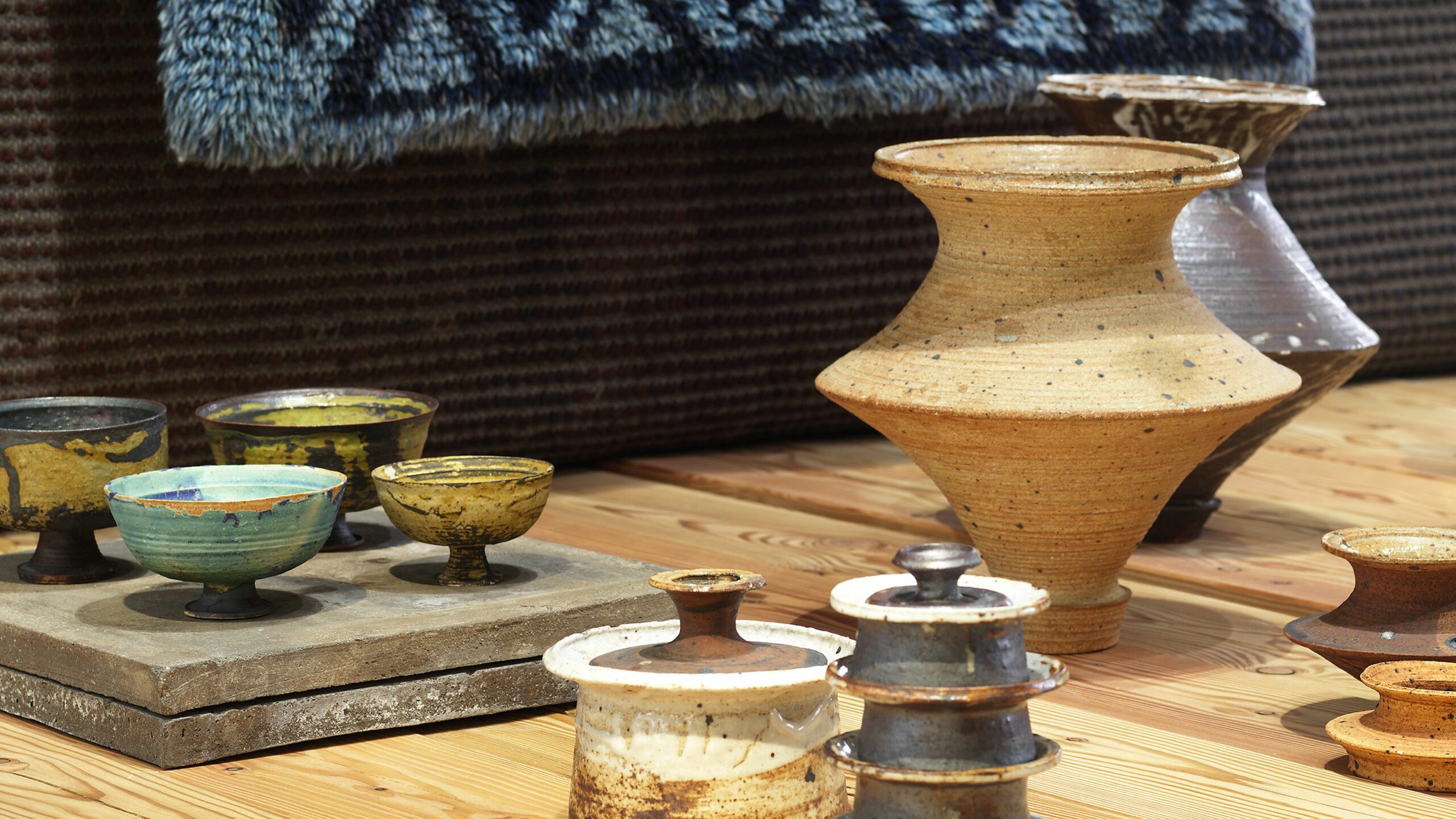Espoo Museum of Modern Art
Mobile guide to the Collection Kakkonen exhibition

Kyösti Kakkonen is a Finnish businessman and notable collector of art and design. Over a period of decades, he has assembled a major collection of over 10,000 objects that holds significant heritage value, comprising both Finnish and international masterpieces from the late 19th century to the present day.
Collection Kakkonen is displayed in a new exhibition space, opened in November 2022, at Exhibition Centre WeeGee. The new exhibit is part of a long-term partnership agreement signed in 2020 by Kyösti Kakkonen, EMMA – Espoo Museum of Modern Art and the City of Espoo. Over 1,400 works from Collection Kakkonen have been deposited at EMMA, highlighting its core, which consists of Finnish ceramic and glass art. The display also features ryijy textiles by prominent designers.
Through artist introductions and seven thematic groupings, the exhibition shares many perspectives on the story of Finnish design. Showcasing both unique art objects and limited editions, it features gems of applied art alongside iconic design classics and contemporary pieces pushing the boundaries of design.
Glass and ceramics are made from natural raw materials. When cared for properly, they can last forever. Their enduring appeal rests upon a legacy of skills and knowledge passed down through generations. The visionary artists featured in this collection have been inspired and influenced by international trends, but their work is also informed by local traditions. The result is a unique creative fusion.
The exhibition is a collaboration between Kyösti Kakkonen, EMMA and the City of Espoo and it has been curated by EMMA’s curator Aura Vilkuna.
Thematic groupings
Story of the Collection

It all began with Toini Muona (1904–1987). After the ceramic artist’s death, Kyösti Kakkonen acquired her entire surviving oeuvre, marking the beginning of his collection and love affair with Finnish design. Today the collection embraces a wide spectrum of one-offs, limited editions, glass and ceramic sculptures, ceramicware and glassware. It comprises numerous internationally celebrated Finnish classics, many of which are loaned out yearly for exhibitions around the world.
Through new acquisitions, a growing number of artists are added to the collection regularly. New artists are selected on the basis of their historical relevance or the special appeal of their oeuvre. The earliest pieces date from the late 19th century and the newest are currently in the making.
Art and Design

Many pieces in the collection are neither art nor design, but can be described interchangeably as ‘art’, ‘applied art’ or ‘design’. The makers also evade labels: one might identify as a ceramicist, another as a visual artist. Others call themselves glassblowers, sculptors or architects.
In the annals of art history, design is often deemed inferior to visual art. The tableware found in our cupboards is rarely displayed on pedestals like ‘fine’ art is. In many cases, it is impossible to say whether a piece is ‘art’ or ‘design’ – nor should it be necessary. Rather than waste time on categories and hierarchies, it is more enlightening to look at parallels between art and design history. A landscape painted on a ceramic dish is every bit as deserving to be called ‘art’ as a landscape on a canvas. A dish can be hung on the wall just as a painting can, and an artist-signed vase is a unique piece equal to any other.
Touching Beauty

It is a natural human impulse to beautify surfaces and create objects purely for aesthetic pleasure. But beauty is a complex thing – it is a personal, subjective experience. It is not only visual, but also tactile: a texture can be aesthetically pleasing. A beautiful object can also touch us inwardly, offering pleasure or solace.
What we regard as ‘beautiful’ is influenced by changing tastes and fashions. Beauty can even be a bone of contention. There have been times in history when vanity has been condemned and strict moral codes have altered prevalent ideas about what constitutes beauty. You can challenge your own ideas by looking for beauty in places you might not expect to find it. Or think about why a certain object is described as beautiful. Where do you find beauty? What feelings do beautiful objects awaken in you?
Ryijy Gallery

Ryijy textiles encapsulate cultural richness and layers of history, whether displayed on a wall as a tapestry or spread on the floor as a rug. Technically, a ryijy is a textile made from a woven base fabric with tufted knots attached to it. Over time, ryijys have served various purposes: as blankets, ceremonial items, and cherished home decorations. In this display, ryijys are presented as artworks within the context of design and art history. The exhibition features ryijys from the 1930s to the 1980s.
Hung alongside ceramics and glass, the ryijys remind us of the intertwined histories of these art forms. In the 20th century, ryijys were showcased in the same applied arts exhibitions as the ceramics and glass creations that brought international recognition to Finland. Kyösti Kakkonen has expanded his collection to include ryijys, focusing particularly on the works of prominent, well-known ryijy designers.
Molten Glass, Fired Clay

Glass and clay have played an important role in human history. Everyday objects and sacred artefacts have been crafted from these materials for thousands of years. Glass was invented as an accidental by-product during the firing of clay. It was initially used as a glaze and only later as its own material. Ceramics and glass have much else in common besides, such as similar raw materials and a reliance on fire. Both are made from natural minerals melted at high temperatures in excess of 1,000°C.
Clay is shapeless without hands to mould it, just as glass needs a glassblower. Both ancient techniques remain in wide use around the world today. Mastering these processes requires great skill and experience. Both are also produced industrially, but hand-made glass and ceramics is easy to tell apart by its quality and distinctive appearance.
Watch videos of artists Alma Jantunen, Heini Riitahuhta and Renata Schirm working on EMMA Zone!
Design Teachers

A kind of family tree can be traced within Finnish design, tracking the artists and the teachers who guided them. Many familiar names from Kakkonen’s collection can be found on the branches of that tree.
In this space, we present six artists whose influence as teachers and role models has been particularly significant. Each of these strong and distinctive personalities contributed to the shaping and development of applied arts and design education in Finland. As teachers and artists, these figures played a crucial role in the making of Finnish design.
Arttu Brummer, Elsa Elenius, Alfred William Finch, Kaj Franck, Kyllikki Salmenhaara, and Timo Sarpaneva taught at an institution originally founded as the Craft School in Helsinki in 1871. Over more than 150 years, the school’s name and location have changed several times. Today, its legacy lives on in the School of Arts, Design, and Architecture at Aalto University in Otaniemi, Espoo.
Forms of Power

Power is a theme invoked by certain pieces in the collection. Artists wield power through the subject matter of their art. But when ideas and values change over time, so do certain meanings. They are products of their historical context, but today they evoke thoughts and feelings that merit open discussion. The works displayed here invite us to contemplate where we have come from, where we are headed, and where we might end up if we fail to respect other people and nature as our equals.
The power of art was harnessed in the project of building Finland’s national identity, especially after the 1940s, when a once-peripheral, war-impoverished nation gained new international visibility with its technical and artistic prowess. Finland won acclaim in international design expositions, thanks not only to talented artists, but also clever marketing. Finland’s identity was built around the idea of a nation with a strong bond with nature.
Artists featured in the exhibition

Collection Kakkonen exhibition features works by Alvar Aalto, Jasmin Anoschkin, Arttu Brummer, Rut Bryk, Elsa Elenius, Alfred William Finch, Kaj Franck, Liisa Hallamaa, Leena-Kaisa Halme, Friedl Holzer-Kjellberg, Annikki Hovisaari, Alma Jantunen, Birger Kaipiainen, Laila Karttunen, Lilli Kollin, Tyra Lundgren, Aino Marsio-Aalto, Francesca Mascitti Lindh, Katri Mattila, Toini Muona, Santtu Mustonen, Gunnel Nyman, Aimo Okkolin, Ritva Puotila, Kirsti Rantanen, Johannes Rantasalo, Heini Riitahuhta, Kristina Riska, Yrjö Rosola, Kyllikki Salmenhaara, Antti Salmenlinna, Timo Sarpaneva, Michael Schilkin, Renata Schirm, Aune Siimes, Uhra-Beata Simberg-Ehrström, Kim Simonsson, Greta Skogster-Lehtinen, Nanny Still, Gerda Thesleff, Raija Tuumi, Oiva Toikka, Terttu Tomero, Kati Tuominen-Niittylä, Helena Tynell, Tapio Wirkkala and Thure Öberg.
The exhibition space includes a wall display that allows visitors to explore the artists represented in the exhibition. You can also read the artist introductions online!
A Matter of the Heart documentary

A Matter of the Heart tells the story of Finnish businessman Kyösti Kakkonen and how his unique art collection found its way on display at EMMA. The documentary takes a peek into Kakkonen’s home, delving into his vast art storage room, and examines the museum’s work with unique art objects. How did Kyösti Kakkonen become a collector? Why did glass and ceramic art become his passion? And how was this large collection curated into an exhibition at EMMA?
Watch the documentary on EMMA Zone! → www.emmazone.fi ←
EMMA Zone is the digital home of EMMA. The site offers a variety content about art, design and the museum’s work under four categories: Thinking Zone, Behind the Scenes at EMMA, Bubbling Under and Children’s Art Questions.
EMMA Zone – always open for art!
The Materials of the Exhibition Space
-


Collection Kakkonen - The Materials of the Exhibition Space
Rammed earth and larch wood have been used in the design of the exhibition space. Read more about the architectural materials here!
Exhibition Team
Curator
Aura Vilkuna
Project management
Katja Oijusluoma, Henna Paunu
Content team
Reetta Kalajo, Katja Oijusluoma, Henna Paunu, Nanne Raivio, Aura Vilkuna
Exhibition architecture and exhibition structures
Aivan Oy, Collaboratorio, Wooden Oy
Graphic design
Aivan Oy, Milla Rissanen
Technical design and construction
Kari Siltala, Simo Karvinen, Lasse Lindfors, Sami Supply, Tarmo Venäläinen
Art handling
Kalle Jarva, Tiina Juuti, Simo Karvinen, Nea Kujala, Lasse Lindfors, Robin Lindqvist, Olli Lukkari, Lasse Naukkarinen, Jussi Pakkala, Jari Rönkkö, Tarmo Venäläinen
Lighting
Jenni Salovaara
Conservation
Tiina Juuti, Simo Karvinen, Nea Kujala, Taina Leppilahti
Registration
Jenni Enbom, Mereca Victorzon
Exhibition texts
Tero Hytönen, Reetta Kalajo, Pilvi Kalhama, Henna Paunu, Nanne Raivio, Pernilla Wiik, Aura Vilkuna
Mobile guide
Nanne Raivio, Helmi Tolonen, Aura Vilkuna
Audience engagement and events program
Reetta Kalajo, Nanne Raivio
Guided tour design
Riikka Alanko
Customer service design
Maija Eränen
Marketing and Communications
Saara Suojoki, Iris Suomi, Helmi Tolonen
Photography and documentation
Ari Karttunen
Script, cinematography and production of the A Matter of the Heart documentary
Laura Eweis, Yehia Eweis
Script, cinematography and production of the artists’ work videos
Ari Karttunen, Aura Vilkuna
Digital artist biography, design and implementation
Ari Karttunen, Lasse Lindfors, Iris Suomi, Helmi Tolonen, Aura Vilkuna, Paula Virta, Aivan Oy
Service sales, visitor surveys
Essi Huhtanen
EMMA Shop
Mira Alanko, Salla Engström
EMMA customer service and guides
Translations
Mats Forsskåhl (Swedish), Silja Kudell (English), Simo Vassinen (English)
The exhibition is co-produced by
EMMA, City of Espoo, Kyösti Kakkonen
Thank you
Juhani Kukkonen
100th Anniversary Foundation of the Finnish Society of Crafts and Design